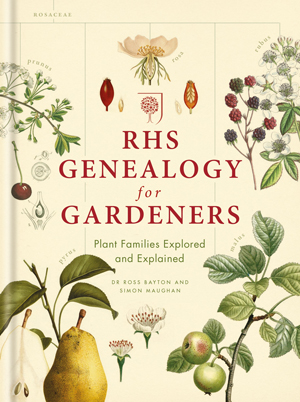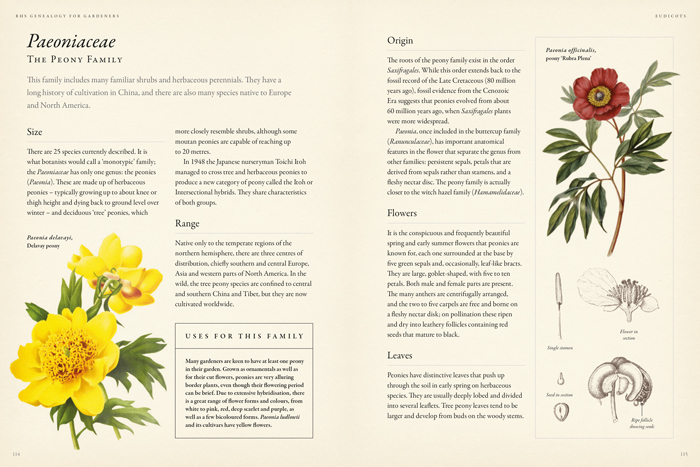RHS Genealogy for Gardeners – Review
‘RHS Genealogy for Gardeners’ – Plant Families Explained and Explored – is the latest addition to the bestselling series that includes RHS Latin for Gardeners and RHS Botany for Gardeners and looks set to be every bit as successful.
‘RHS Genealogy for Gardeners‘ is written by Dr Ross Bayton and Simon Maughan and follows the same style and pattern as the former RHS publications in the series. It is an informative, easy-to-understand reference exploring plant families and the plant family tree in detail.
From roses (Rosaceae) to rhubarb (Polygonaceae) and carrots (Apiaceae) to camellias (Theaceae), the book unlocks a wealth of practical information to help you identify, select and cultivate plants from over 70 families, most familiar to gardeners.
As someone who is totally comfortable with family genealogy but very uncomfortable with plant genealogy, I was anxious to see if this book would shed a little light on my shortcomings and hopefully help me grasp, what I have to confess hitherto has been a bit of a blind area.
As the authors point out in the Preface, ‘when it comes to being a good gardener, making connections is what it is all about.’ Knowing what can grow in your type of soil so you can broaden your planting ideas to include other plants in the same plant family, is one instance of this.
The Introduction is extensive. There is a clear and concise ‘How to use this book’ page at the beginning followed by an introduction to plant family trees and of course the Scientific Nomenclature (certainly something I have difficulty with). The ‘Plant Family Tree’ illustrates a range of plants, created by comparing DNA samples, and this too is easy to follow and informative.
Having progressed that far the authors then go on to look at the first plants to flowers, what to look for when identifying plants, different plant types and roots and stems. Leaves, flowers, fruits and seeds are included, so by the end of the Preface you certainly have the basics to appreciate and use the rest of the book.
I found the Keys to major groups in the Introduction really useful with clearly set out diagrams and very helpful in leading you to identification of plants.
Chapters include the Gymnosperms, Monocots and Early Angiosperms, and Eudicots, and if you have grasped the family tree, a lot begins to make sense.
Within each chapter the various plant families are covered and beautifully illustrated. Each family identification gives information on size, range, origin, flowers and fruit, leaves and uses for the family. There is a glossary of botanical terms and a comprehensive index at the back.
 I really like the approach the RHS has taken to this series of books as they are both informative and attractive. In some ways they remind me of Arts and Crafts gardening books, perhaps this is intentional, perhaps not, but the layout to me certainly engages and makes it easier to dip in and start learning.
I really like the approach the RHS has taken to this series of books as they are both informative and attractive. In some ways they remind me of Arts and Crafts gardening books, perhaps this is intentional, perhaps not, but the layout to me certainly engages and makes it easier to dip in and start learning.
Whether you are a gardener, horticultural student, budding botanist or plant enthusiast, ‘RHS Genealogy for Gardeners‘ will help you understand and appreciate the extraordinary diversity and unrivalled splendour of the plant kingdom. It certainly helped me come to grips with a lot of things I didn’t know and started a thinking process about plant families which I feel sure will help me in my own gardening.
Simon Maughan has spent 25 years furthering his knowledge and developing a love of practical gardening and plants. He worked on the RHS A-Z of Garden Plants in 1995 and has worked on dozens of gardening books covering all aspects of the subject. He has worked as an editor and publisher for the RHS for over 12 years.
Dr Ross Bayton, is co-author of New Trees: Recent Introductions to Cultivation and used to work for BBC Gardeners’ World Magazine.
‘RHS Genealogy for Gardeners’ – Plant Families Explained and Explored – by Dr Ross Bayton and Simon Maughan is published in hardback by Mitchell Beazley in association with the Royal Horticultural Society priced at £14.99.
Review copy kindly supplied by the publisher.
All illustrations are ©of the publisher and RHS.




